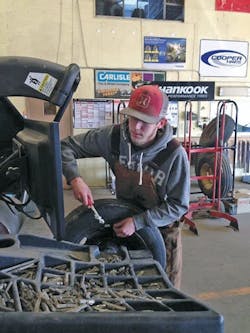The economy is giving the green light to light truck tire sales. Pickup trucks are the most popular new vehicles sold in the U.S., and a majority of the fastest-selling used vehicles are trucks and SUVs. Lower gas prices are helping Americans fall back in love with bigger, less fuel efficient rides.
So that means independent tire dealers are stocking and selling more light truck tires, right?
Kind of.
At Montalbano Tire & Auto Service in Houston, Tony Montalbano says business is good at the shop his parents opened in 1941. He sells more truck and light truck tires than anything else, and sees customers holding onto their trucks for longer than ever. It’s a big boost to business. “They’re keeping them longer and we’re reaping the benefits.
“Trucks are a big part of our business. We do all trucks. Big trucks, little trucks, cars, we do them all. And we have service trucks to go on the road to do that, too,” Montalbano says.
But because Texas’ economy depends so heavily on the oil and gas industry, Montalbano is keeping his optimism in check.
“When that flows, everything’s flowing good. But they’re laying off a lot of workers from Halliburton. They’re getting laid off and when that happens it’s going to trickle down somewhere,” he says. “I’ve been through it before so we know what to expect. Even though Houston has attempted to diversify, that’s fine and dandy, but it all goes back to the money oil and gas people spend.”
Rick Pilger, owner of Pilger’s Tire & Auto Center in College Station, Texas, is all too familiar with Montalbano’s concerns.
“The low gas prices are great, but the $48 for a barrel of oil isn’t.”
As long as the oil companies’ employees and vehicles remain on the road, Pilger says things are OK. But once service workers are laid off, there’s a problem. And it’s not just in selling fewer tires.
“If they’ve got ’em parked, they’re not changing the oil, replacing the brakes.
“It’s not significant at this point, at least not in our area,” Pilger says, but business at his shop is balanced by the 50,000 students and 3,500 faculty members at Texas A&M University. “It’s a little bit of a buffer for our economy. We don’t feel the ups and downs quite as bad.”
Promising economic indicators
While lower gas prices prompt customers to drive more, and thus eventually purchase new tires, Nick Mitchell, senior vice president and research analyst for Northcoast Research Holdings LLC, says it’s going to take time for tire dealers to reap those benefits.
“If you drive 15,000 miles per year, even if you drive 5% more, and that’s a lot, that’s only 750 miles. That’s not going to make or break the longevity of a tire,” Mitchell says.
The quicker turnaround may come from another key statistic: Every penny drop in the price of gasoline leaves approximately $1 billion in the pockets of consumers.
“That’s where you’re really going to get your bang for your buck,” Mitchell says.
“Whether you know you need new tires or your service tech tells you that you need new tires, with that money in your pocket you’re in a better position,” he says. “It still needs the catalyst to show up at the dealer, so it’s going to be more of a gradual benefit. And because we’re on the back half of winter, you’ll probably start to see the real benefit from the gas prices in the spring, when drivers are doing other maintenance, or maybe not until October or November when they’re buying snow tires and preparing for winter.”
New pickup sales in January were up 21.9% in the U.S. from the same month a year earlier, and sales of small, midsize, large and luxury SUVs were up as well, according to data from motorintelligence.com published in The Wall Street Journal. The biggest jump — of 74.3% — was in the large SUV category.
The overall increase in pickup sales matches the news from Ford Motor Co., home of America’s best-selling vehicle, the Ford F-150. January 2015 was the F-Series’ best month for sales volume in more than a decade, the automaker says.
But the good news isn’t limited to new vehicle sales. At the same time, 22 of the 30 fastest-selling used vehicles are trucks and SUVs, according to Edmunds.com.
For its part, the Rubber Manufacturers Association is predicting a slight increase of 0.3% in replacement light truck tire shipments in 2015 — to 29.7 million. The original equipment shipments are a bit more encouraging for 2015 — up 2.1%.
[PAGEBREAK]
Gravel and tariffs
Matthew Jost is the third-generation owner of Jost Tire Co., in Owensville, Mo., a town of about 2,600 people in east-central Missouri. He sells 800 tires a month through his retail store, and more with a small wholesale route that takes him to shops in neighboring towns.
About 40% of his retail sales are light truck tires. Jost inventories 35,000 to 40,000 tires, a stock he says outnumbers anyone nearby. Only stores two hours away in St. Louis carry as many or more tires than he does.
“We have a high demand for light truck tires compared to passenger tires, but that’s more of where I live,” Jost says. “We have more gravel roads than pavement.”
Jost says those roads eat tires and cause most customers to replace them more quickly than drivers in a completely paved community.
“Most husbands drive trucks and their wives drive Tahoes or Suburbans. Our community goes through a lot of tires.”
Jost and other dealers say they’re waiting for suppliers to announce price increases. He hopes to get ahead of the curve and ramp up inventory before the increases come into effect, and says his customers are hoping for the same thing.
“A lot of guys are seeing it in the papers. We take a lot of phone calls,” he says, referring to the anti-dumping and countervailing tariffs on Chinese-made tires.
In Texas, Montalbano refers to the tariff as “the Obama tax,” and he admits he’s already tried to buy and store more light truck tires, as well as passenger tires, in anticipation of industry-wide price increases. He wasn’t successful.
“I tried to buy up as many as I could at the old price. Tires I used to buy for $76 to $77 now cost me $89. That’s not imagined, that’s the truth,” Montalbano says. “I tried to get ahead of the curve. Some of my suppliers have quit certain manufacturers they felt were too high, so they’ve completely switched lines, so we’re having to adjust what we do.”
About a quarter of his business is selling tires made in China, and Montalbano says there’s a place for those products in the market. “The Chinese tires do a good job for us. I don’t want to sound un-American, but there is a market for these tires and people buy them. It serves a purpose. It serves a need. But there’s a place for Goodyear and Michelins as well.
“When it comes down to it, if they’re going to spend $119 for a Chinese tire, they’re not going to spend $225 for a Michelin. It’s just a matter of what they can afford and what it takes to get them over the next hill.”
No jumps yet
Joy Kokaisel says light truck tire sales are steady at Norm’s Tire Sales Inc., the business her father opened 61 years ago in Roseville, Minn. She now owns it with her nephew Nick Strohbeen. She hasn’t seen any kind of jump in sales to correlate with gas prices, though October and November were “record-breaking months.” She attributes that to an early snow.
And at this shop outside the Twin Cities, Kokaisel notes it’s not the Ford F-150 driving light truck tire sales. It’s the Chevy Silverado.
Trent Fuhrman, chief financial officer for Tire-Rama Inc., says overall, sales in 2015 are up compared to the previous year, which he attributes to lower fuel prices. But he hasn’t seen a surge specifically in light truck tires at the company’s stores in Idaho, Montana, Washington and Wyoming.
“You would think it would spur some sales, but we’re not seeing that yet,” Fuhrman says.
Steve Cain, general sales manager for Dobbs Tire & Auto Centers Inc., has a theory for why Dobbs’ 40 stores haven’t experienced an uptick in light truck tire sales.
“The gas prices haven’t been low enough long enough,” Cain says.
Plus, in the Midwest Cain says a “warmer than normal” winter hasn’t triggered tire sales in the St. Louis, Mo., area where the company operates.
Opposites on the coasts
Brett Mallen, owner of House of Tires, says the assumptions about light truck tire sales following lower gas prices make sense, but they’re not panning out at his tire dealership in Levittown, N.Y. His increase in light truck tire sales has been a gradual one with the popularity of SUVs. Today light truck tires account for 40% of his inventory, and he estimates that has quadrupled over the past decade.
At Bruce’s Tire Inc., owner Richard Howard says he knows one thing. Business is good. No, “business is really good.
“I don’t know what to attribute it to, but maybe it’s more disposable income,” Howard says. “Customers are not shopping as much.”
By shopping, he means they’re not agonizing over every penny on an invoice. “Not asking ‘can you knock $50 off the bill?’ It seems they feel a lot better with gas prices down,” Howard says.
“Business in general is way up. Across the board,” Howard says. “For a while it was kind of rough.” ■
About the Author
Joy Kopcha
Managing Editor
Joy Kopcha joined Modern Tire Dealer and Auto Service Professional as senior editor in 2014 after working as a newspaper reporter for a dozen years in Kansas, Indiana and Pennsylvania. She was named managing editor of MTD and ASP in 2022, and took on that same role with Motor Age in 2024.
She is an award-winning journalist, including in 2023 when she was named a Jesse H. Neal Awards Finalist.
Don't miss any of her articles. Sign up for MTD's newsletters.

